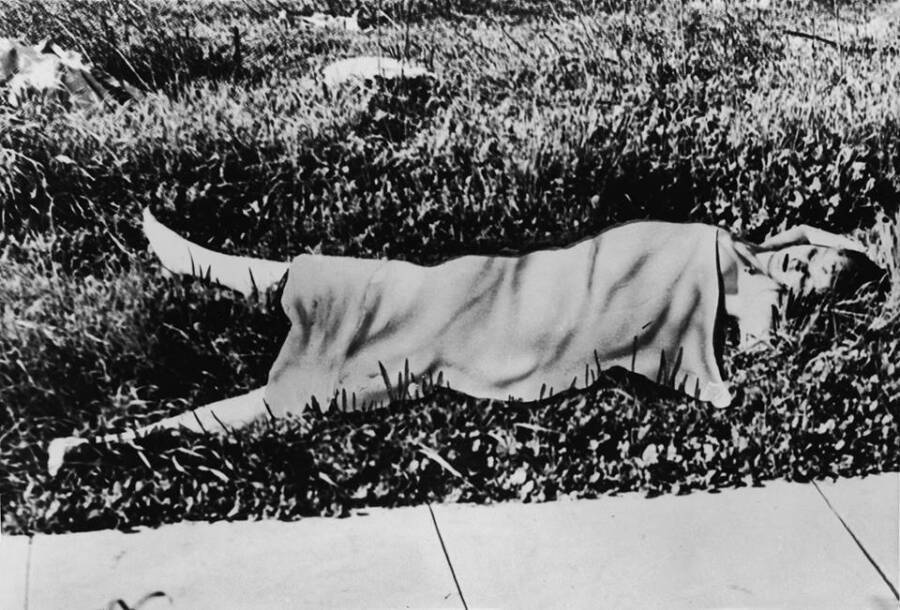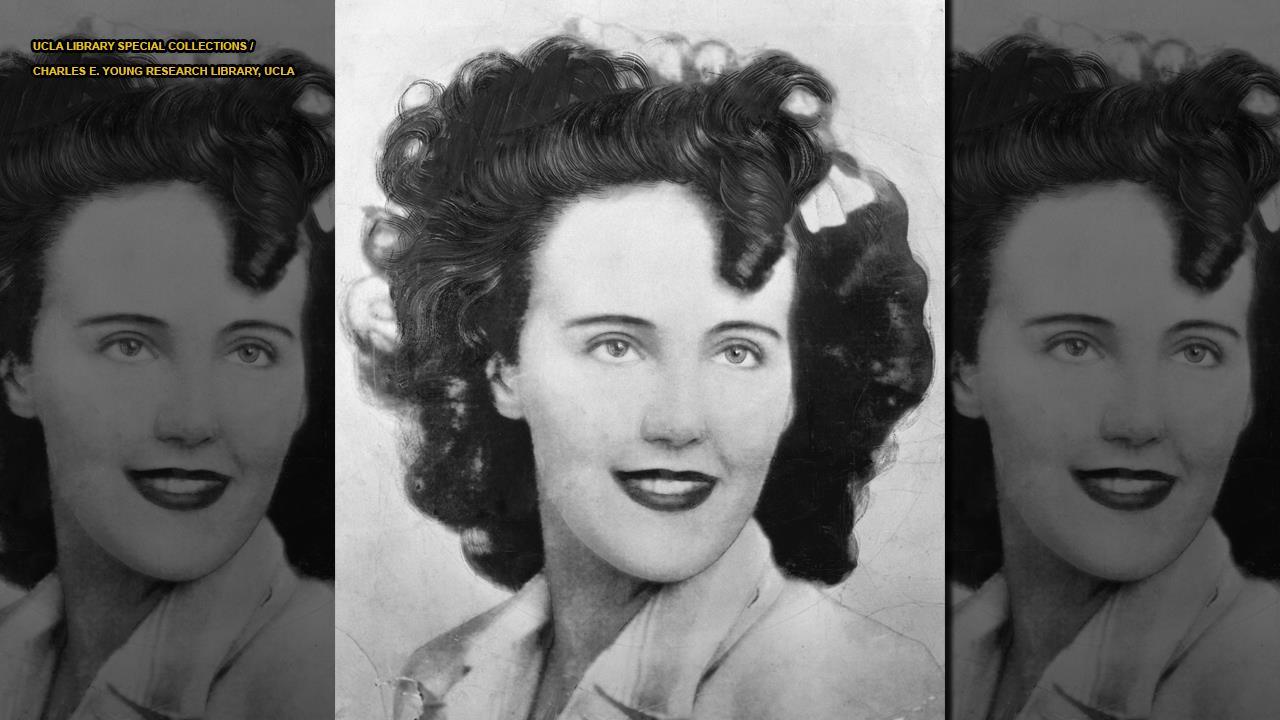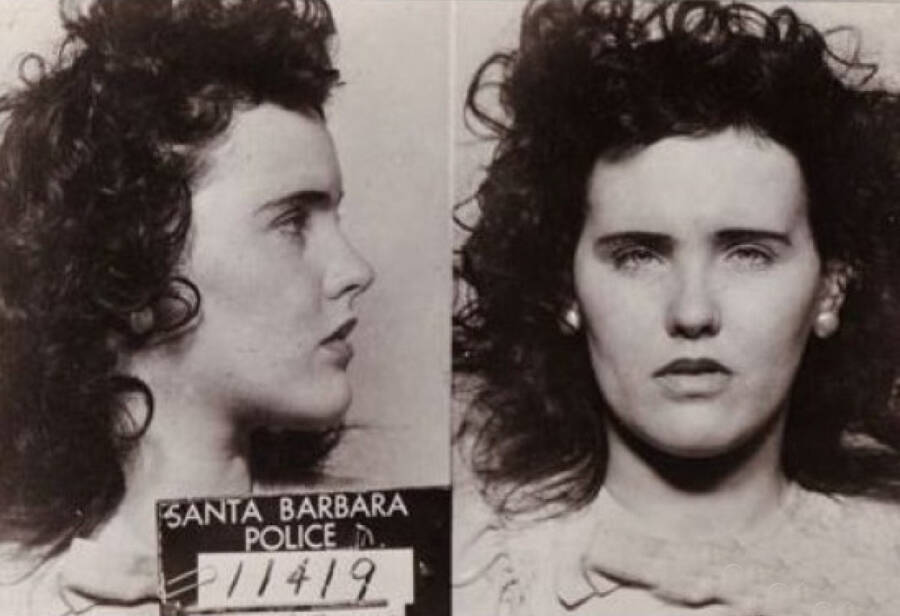Black Dahlia: Unveiling The Mystery - Photos, Autopsy & More | [Guide]
Why has the name "Black Dahlia" become synonymous with one of the most gruesome and enduring unsolved mysteries in American history? The moniker, a haunting echo of a beautiful, yet tragically short life, perfectly encapsulates the brutal murder of Elizabeth Short, a case that continues to captivate and disturb generations.
On the morning of January 15, 1947, a scene of unimaginable horror unfolded in the Leimert Park neighborhood of Los Angeles. A woman, taking a walk with her child along the 3800 block of Norton Street, stumbled upon a sight that would forever be etched in the annals of crime: the mutilated body of a young woman, later identified as Elizabeth Short, brutally murdered and left in a vacant lot. The victim, whose body was bisected and horrifically arranged, became instantly known as the "Black Dahlia," a nickname bestowed upon her by the media, a chilling testament to her dark hair and the macabre nature of her demise. The case, despite a massive investigation involving over 150 suspects, remains unsolved, a cold case that continues to haunt the city and intrigue the public. The disturbing images provided investigators with vital photographic evidence, and shocking the world. These photos of her body, brutally severed in half and drained of blood, highlighted the sheer brutality of the crime. The case has become a symbol of unsolved crime, with every detail of the case still kept in the minds of people. The question arises, why has the mystery around the Black Dahlia continued for so long? It all began with one tragic day in 1947, where one murder took place, and has continued to shock the world even after 75 years.
| Attribute | Details |
|---|---|
| Full Name | Elizabeth Short |
| Known As | The Black Dahlia |
| Born | July 29, 1924, Boston, Massachusetts |
| Died | January 15, 1947, Los Angeles, California |
| Age at Death | 22 |
| Nationality | American |
| Occupation (at time of death) | Aspiring Actress |
| Marital Status | Single |
| Cause of Death | Homicide (Brutal Murder) |
| Crime Scene Location | Vacant lot in Leimert Park, Los Angeles, California (3800 block of Norton Street) |
| Notable Features | Black hair, dark eyes, petite build |
| Case Status | Unsolved Cold Case |
| Investigating Agencies | Los Angeles Police Department (LAPD) |
| Number of Suspects | Over 150 |
| Famous Books and Documentaries | "The Black Dahlia" by James Ellroy, numerous documentaries and true crime investigations |
The circumstances surrounding Elizabeth Short's death were, and remain, extraordinarily disturbing. The gruesome details of the crime scene, as captured in the "death and autopsy photos" and the photos of the crime scene in Leimert Park, painted a picture of a calculated and sadistic act. Her body, found severed in half, meticulously drained of blood, and arranged in a deliberately provocative manner, spoke volumes about the killer's intent. The photos, now a part of history, show the brutality of the crime and the morbid details. Forensic photographs, some unearthed by investigators and authors, provided crucial evidence, but the identity of the perpetrator remained elusive, and the motive unclear. The investigation became a media frenzy, with the press dubbing her "The Black Dahlia," a name that stuck, reflecting her dark hair and the grim nature of the case. The name immediately became famous, embedding this murder in public consciousness.
- Secure Remote Iot P2p Connections On Android Your Guide
- 607 Unc Net Worth Forbes Insights Financial Analysis
The case quickly became a media sensation, and with this came countless theories, speculation, and a deep dive into Elizabeth Short's life. Newspaper pages from 1947 to 1957 are filled with articles covering the "Black Dahlia/Elizabeth Short case." Photo subjects include suspects, family and friends, and personalities related to the case, including evidence and the crime scene area. The investigation was vast and comprehensive, and the fact that the crime remained unsolved only added to the public's fascination. The sheer number of suspects and the resources dedicated to solving the crime underscore the importance of the investigation. The case highlighted the challenges of criminal investigations and the mysteries that can remain despite intense scrutiny. The abuse unleashed on the victims corpse became a frequent topic of discussion, a chilling reminder of the brutality of the crime. In the days and months following the discovery of Short's body, the investigation became a city-wide obsession, with the Los Angeles Police Department working tirelessly to find her killer. The "Black Dahlia" became a symbol of the underbelly of Hollywood, the dark side of the glamorous dream that attracted so many hopefuls to the city. The black dahlia autopsy details revealed that the victim was an aspiring actress when she was found murdered on January 15, 1947. The investigation led to numerous dead ends. Despite the attention, the murder case remained a cold case, and Elizabeth Short, the "Black Dahlia," was never given justice.
The investigation into the murder of Elizabeth Short involved a multitude of individuals, each playing a role in the pursuit of justice, the unraveling of the mystery, and the dissemination of the story to the public. Although the Los Angeles Police Department (LAPD) led the official investigation, numerous other figures entered the scene. In this investigation, hundreds of shots were unearthed while combing through the museum's extensive collection of forensic photographs. The author of the Lloyd Hopkins trilogy and the Black Dahlia also played a huge role in unearthing and uncovering information about the case. The public, the media, and those with a personal connection to Elizabeth Short contributed to the narrative and influenced the perception of the crime.
Despite the enormous effort of the investigation and the vast amount of information available, the case remains unsolved to this day. The lack of closure has fueled public fascination and led to persistent speculation and theories. The mystery has continued for 75 years, with new theories emerging, and a number of potential suspects being named. Several books and documentaries have been made to uncover more of the information behind the case. The absence of a definitive answer has made the Black Dahlia case a symbol of unsolved mysteries and the limits of human justice. Even today, the cases legacy and its ability to ignite the imagination. The enduring fascination with the Black Dahlia case highlights the power of a compelling narrative and the human tendency to seek answers, even in the face of profound mystery. The absence of a definitive answer has kept the public's attention locked onto the case, and the investigation continues to this day.
- 1990 Topps Baseball Cards Values Rookies Grading Explore Now
- Somali Wasmo Telegram Find Links Stay Safe In 2024 Beyond
The lingering questions surrounding the Black Dahlia case are complex and numerous. One central issue is the lack of solid, conclusive evidence. Despite the extensive investigation, no definitive forensic evidence, such as fingerprints, DNA, or a confession, has definitively tied any specific individual to the murder. The absence of this crucial type of evidence has made it very difficult for law enforcement to build a prosecutable case. The case has been mired in a web of rumors, speculation, and conflicting accounts. Several individuals have been put forward as potential suspects, but the lack of solid evidence makes it hard to ascertain the involvement of any of them. The lack of clarity concerning the identity of the killer or their motive contributes to the ongoing sense of mystery. These factors all contribute to the unresolved nature of the Black Dahlia case and its enduring place in the annals of unsolved mysteries.
The legacy of the Black Dahlia case is profound and multifaceted. The case's impact on popular culture has been substantial. The name "Black Dahlia" itself has become a cultural touchstone, instantly recognizable and associated with a sense of mystery and tragedy. The story has been adapted in numerous films, books, and television shows. The influence of the case is also seen in crime writing, film noir, and true crime media. The Black Dahlia has inspired countless works of fiction and non-fiction, shaping public perceptions of the criminal underworld. The case has also had a lasting impact on the perception of Los Angeles, particularly the city's darker aspects. The case evokes images of the underbelly of Hollywood, corruption, and the dark side of fame. It is a dark reminder of the reality of the city's history. The case also serves as a caution against the dangers of sensationalism and the pitfalls of unchecked speculation. The case continues to capture the public's imagination.
The public's interest in the case is further fueled by the nature of the crime itself and the way it was presented to the public. The horrific nature of the murder, the mutilation of the victim's body, and the public display of the crime scene photos all contributed to the enduring impact of the case. The shocking nature of the crime, coupled with the details released to the public through the media, captured the public's attention. The sensational reporting of the case kept the public interested. In addition to the gruesome details of the murder, the case captured the imagination of many due to the victim's background. Short was a young woman with ambitions of becoming an actress in Hollywood, adding a layer of allure and tragedy to the case. The contrast between the victim's aspirations and the tragic outcome further propelled public interest. Her death became a symbol of unrealized dreams and the perils of fame. The combination of a mysterious crime, a beautiful victim, and an unresolved case makes the Black Dahlia an exceptionally interesting case.
The case has also influenced the development of forensic science and criminal investigation techniques. The Black Dahlia case took place at a time when forensic science was still in its infancy. The investigation highlighted some of the limitations of forensic techniques and the importance of thorough investigation. The case spurred the evolution of investigative techniques and forensic methods. The failure to solve the case demonstrated the need for more scientific analysis and improved investigative methods. In the years following the Black Dahlia case, the development of forensics, especially DNA analysis and other cutting-edge technology, has increased the ability of investigators to solve complex crimes.
The unanswered questions, the lack of closure, and the enduring mystery ensure that the Black Dahlia case will remain a topic of discussion for years to come. As the case continues to captivate, it continues to be a reminder of the human capacity for both extraordinary cruelty and the relentless quest for justice. Despite the lack of a final resolution, the memory of Elizabeth Short and the mystery surrounding her death live on. The unanswered questions and the incomplete nature of the case provide an enduring narrative and continue to be a part of history. The "Black Dahlia" case is a reminder of the complexity of human nature, the power of storytelling, and the enduring allure of unsolved mysteries. The case's longevity in the public mind is a testament to its intriguing nature, its impact on society, and its unresolved status.



Detail Author:
- Name : Douglas Gerlach
- Username : ustark
- Email : gusikowski.sigmund@gmail.com
- Birthdate : 2002-07-01
- Address : 2990 Augustine Bypass Retahaven, KY 93839-7166
- Phone : (269) 614-6249
- Company : Kunde Ltd
- Job : Automotive Specialty Technician
- Bio : Beatae magni doloribus architecto et itaque non quis. Voluptatem neque et quia atque. Suscipit et aut est quod occaecati at.
Socials
facebook:
- url : https://facebook.com/guyhayes
- username : guyhayes
- bio : Et consequatur tempora id sit magnam incidunt impedit quasi.
- followers : 3536
- following : 1940
tiktok:
- url : https://tiktok.com/@hayes1997
- username : hayes1997
- bio : Molestiae in minima sed saepe est. Ipsum id quam et qui dolores accusamus ut.
- followers : 4179
- following : 2377
instagram:
- url : https://instagram.com/hayes2009
- username : hayes2009
- bio : Rerum voluptatem tenetur iste a. Veniam odit aut molestiae soluta quo iusto.
- followers : 3977
- following : 1871
twitter:
- url : https://twitter.com/guy.hayes
- username : guy.hayes
- bio : Magni aut consequatur et aperiam et vitae. Totam provident sint rem eos ut odio. Quia magni neque at.
- followers : 1254
- following : 478